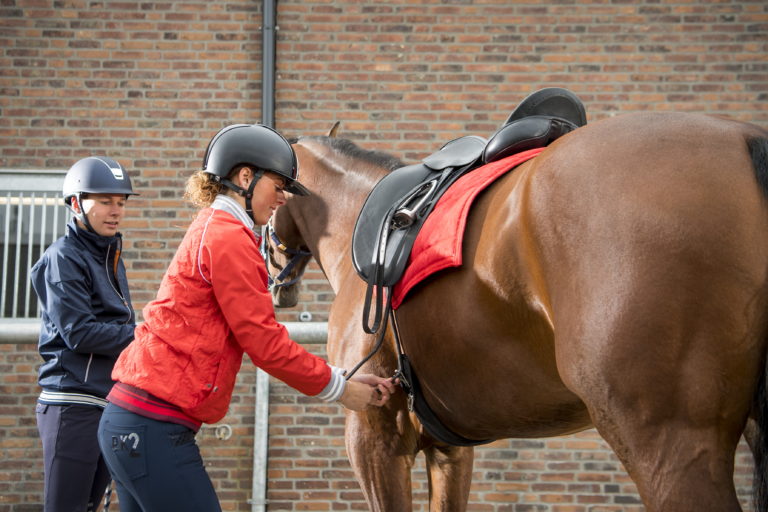Adding cross-training to a dressage program is analogous to adding that special hint of spice to a recipe. Everyone is fascinated by its inclusion and curious as to why this particular ingredient changes the recipe’s intricacies, depth and structure. Although certainly not a new concept, the inclusion of cross-training has gained increased visibility and following within equestrian sports because of its indisputable ability to hone performance physically and emotionally within a relatively short period of time. In this article I will share how my previous experience as a gymnast has influenced my approach to dressage, explain the benefits of cross-training and offer some exercises for you and your horse.
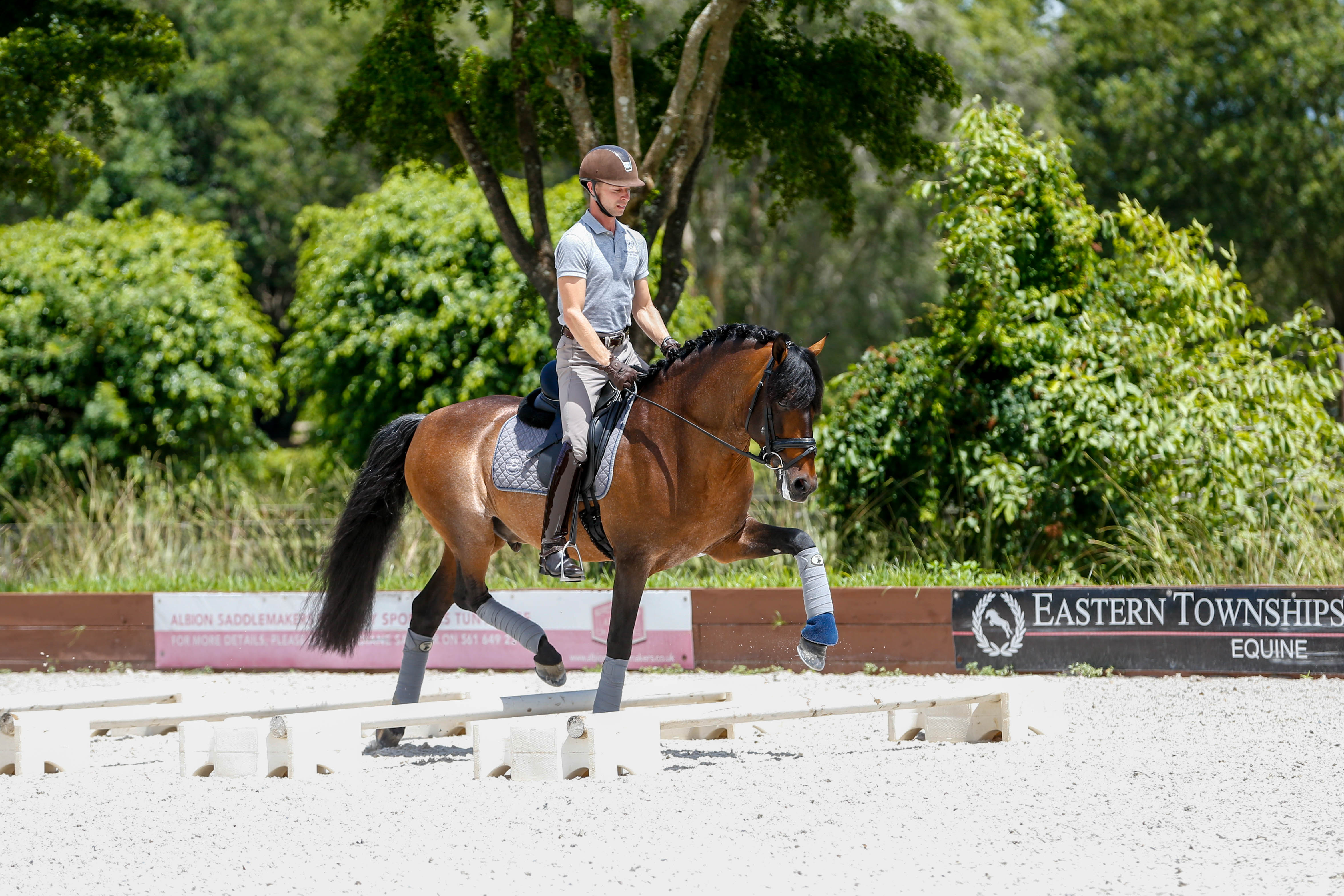
Gymnastics Versus Dressage
I’ve been a rider since I was old enough to ride, but I took time off from riding to focus on elite gymnastics until I was 12 years old. Once I became a professional rider, I went back to gymnastics for fun and fitness. Basically, I was tired of doing the same weight routine at the gym and needed something different to motivate me. This has given me the distinct advantage of viewing both sports from various angles and has allowed me to notice and appreciate the similarities between riding and gymnastics. As a child in gymnastics, I simply did what the coaches told me to do. But as an adult, I understood how to break down each skill into several different parts and bring the use of repetition and muscle memory to each of those parts. With this knowledge of a systematic approach, I was then able, in time, to execute more difficult movements such as a backward somersault.
As in gymnastics, the goal in dressage training is to master a movement by breaking down the different aspects. Once we are able to master each element of a specific movement, we can perform more advanced work. For instance, a working canter becomes a collected canter, a shoulder-in becomes a half pass and a half pass becomes a pirouette. The more difficult movements can become possible because the foundation has been well established. Muscle memory of both the horse and rider are elements of training that we don’t always devote enough thought to, and often we don’t rely on those abilities once they are developed. Sometimes you just have to trust your body or your horse’s body and allow muscle memory to take over.
The Benefits of Cross-Training
Cross-training is good for all athletes, including horses. If a dressage rider cannot control his own body, then he cannot expect to be able to control his horse’s body. Fitness of the rider can only improve overall control and awareness of self. If a rider cannot carry his own body, then high expectations for the horse to be in self-carriage are not fair. Horses always find our shortcomings, asymmetries or structural imbalances. If a rider finds a pattern from one horse that carries over to the next horse, the rider should examine that pattern and recognize that perhaps it’s his issue and his responsibility to fix.
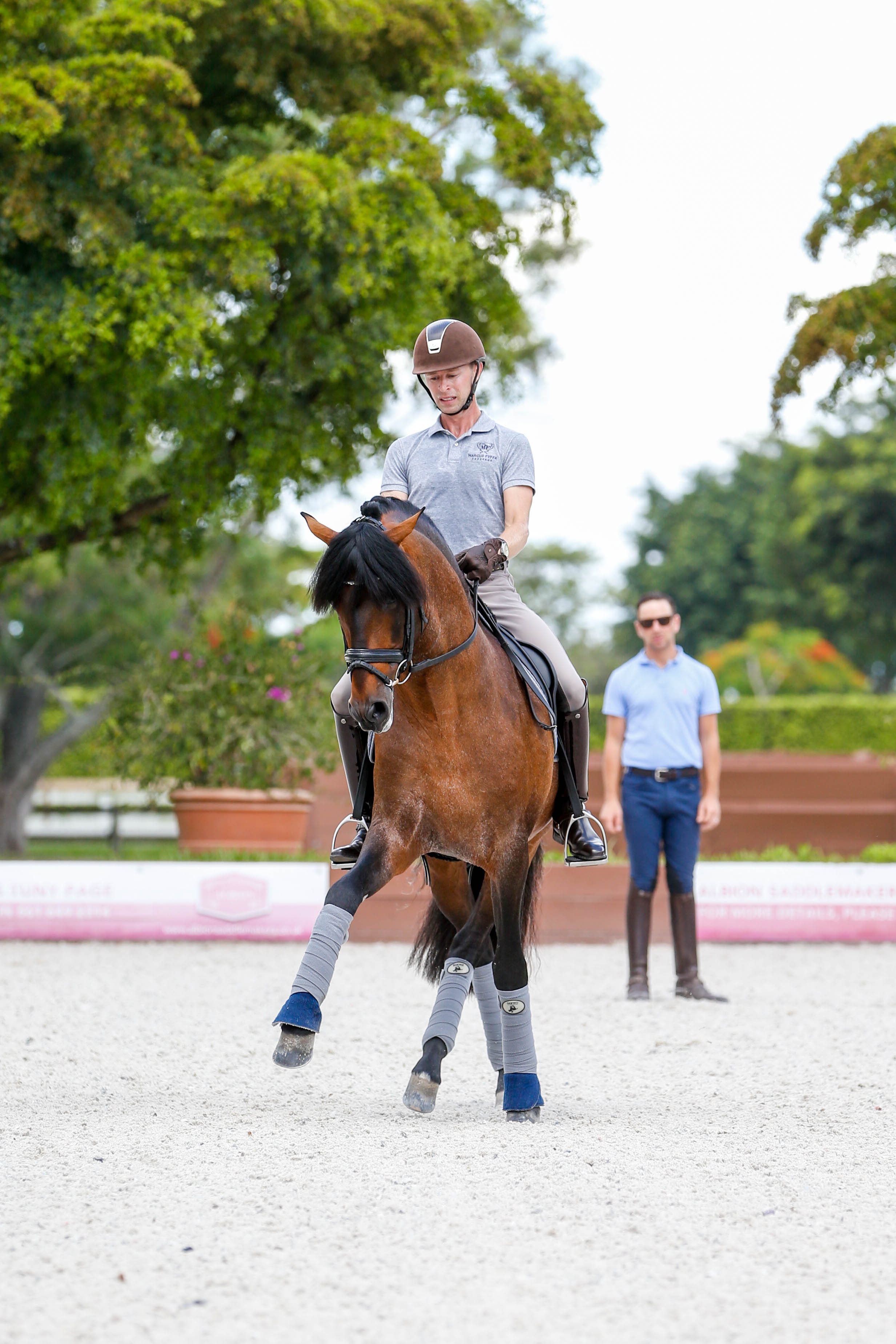
I’m fortunate that I’m almost always riding with my husband, David Marcus, U.S. dressage coach Robert Dover or one of the other top professionals based at our barn. For me, that’s the best situation to be successful. It’s also helpful to have educated observers positioned along short sides and at the end of each long side. We often video our rides as well, looking for symmetry in the rider, for the correct weight distribution in both stirrups and seat bones that are even. A rider should be able to influence one aspect of the horse without losing control of another part of his or her own body. Self-carriage of the rider can ultimately create self-carriage of the horse.
When it comes to choosing a cross-training program, it’s important to remember to find an activity that is suited to the rider’s personality and goals. For instance, there’s no point in me deciding to start swimming when I know I’m not motivated by it. The same principle holds true with cross-training as it relates to the horse. I personally enjoy lifting weights and stretching at the gym and doing yoga. As an adult, the biggest issue I had doing gymnastics for cross-training was that while I was more fit and more flexible, I was also sore. Stiffness surfaced when I tried something new or increased the intensity of my workout, and I realized how much my body hurt. Surely when we are developing horses, muscle soreness has to be a factor for them, too. Take this into consideration when your horse feels a little less motivated after having a groundbreaking ride a day or so before. Be sympathetic, but remember, the best thing for sore muscles is to keep them mobile and moving.
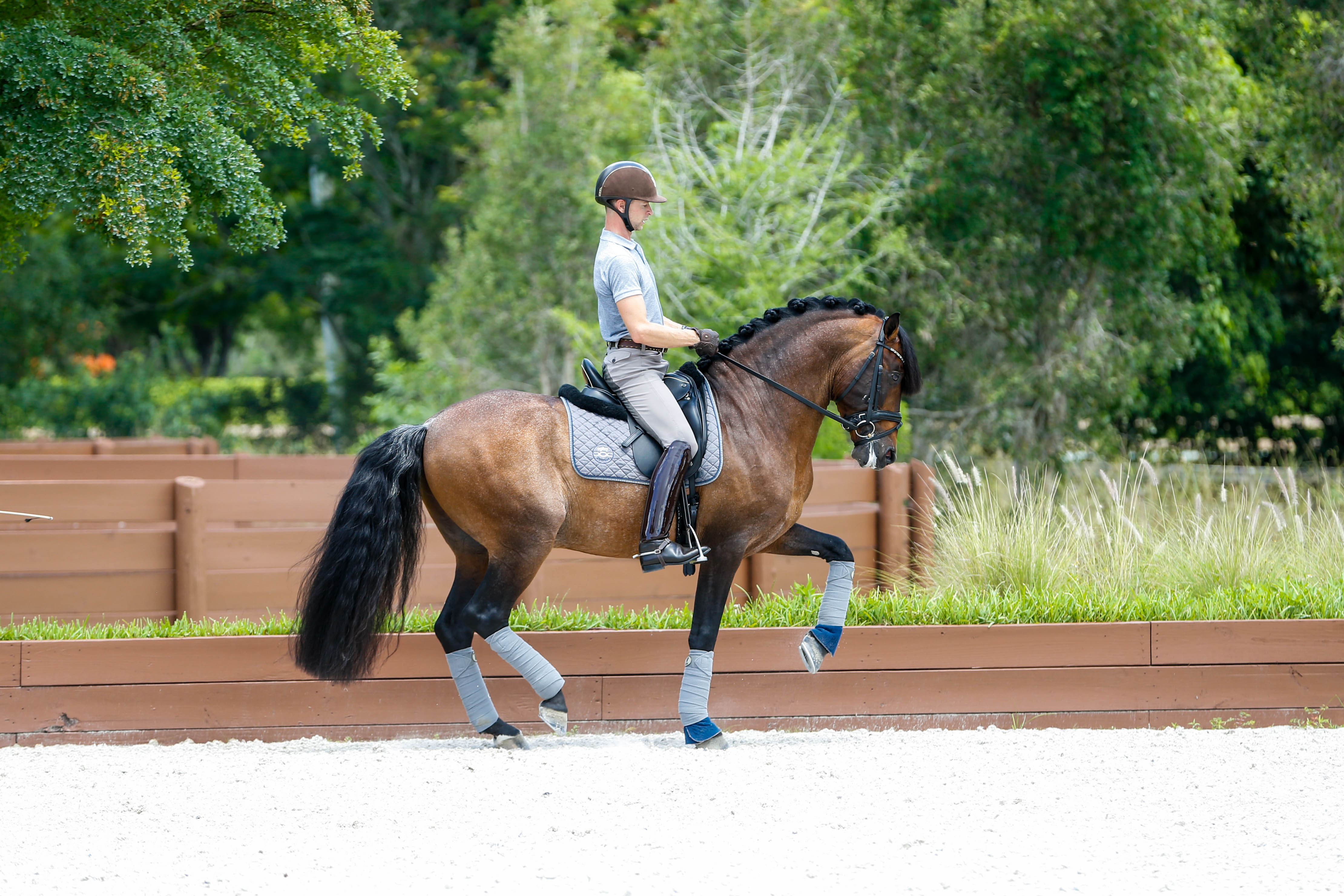
Like any athlete, if you are doing the exact same workout everyday, you’ll eventually experience some level of fatigue, both physically and emotionally. To address this when we work with horses, our preference is to isolate different muscle groups. A 4-year-old horse compared to a trained Grand Prix horse has a smaller spectrum of movements he is able to perform. For a weaker horse, the spectrum is also not so broad, however a Grand Prix horse, for example, knows how to do flying changes, half passes, piaffe and passage. That’s a broad spectrum, and I personally feel horses don’t need to be doing all of these movements every day.
Instead, we like to separate the exercises by muscle groups and level of difficulty and intensity. For example, we may do more trot movements one day that may include half passes and extensions, the canter tour the following day that includes pirouettes and flying changes, and then train the piaffe and passage on a separate day. Of course, a trained Grand Prix horse needs to be able to perform this entire spectrum in a single test. This doesn’t necessarily mean that training each of these movements consecutively and daily will produce the best results and the happiest horse. It is a balance when developing a training program where multiple factors are taken into consideration, including the age and level of the horse, personality of the horse and rider and the dates of the actual competition goals.
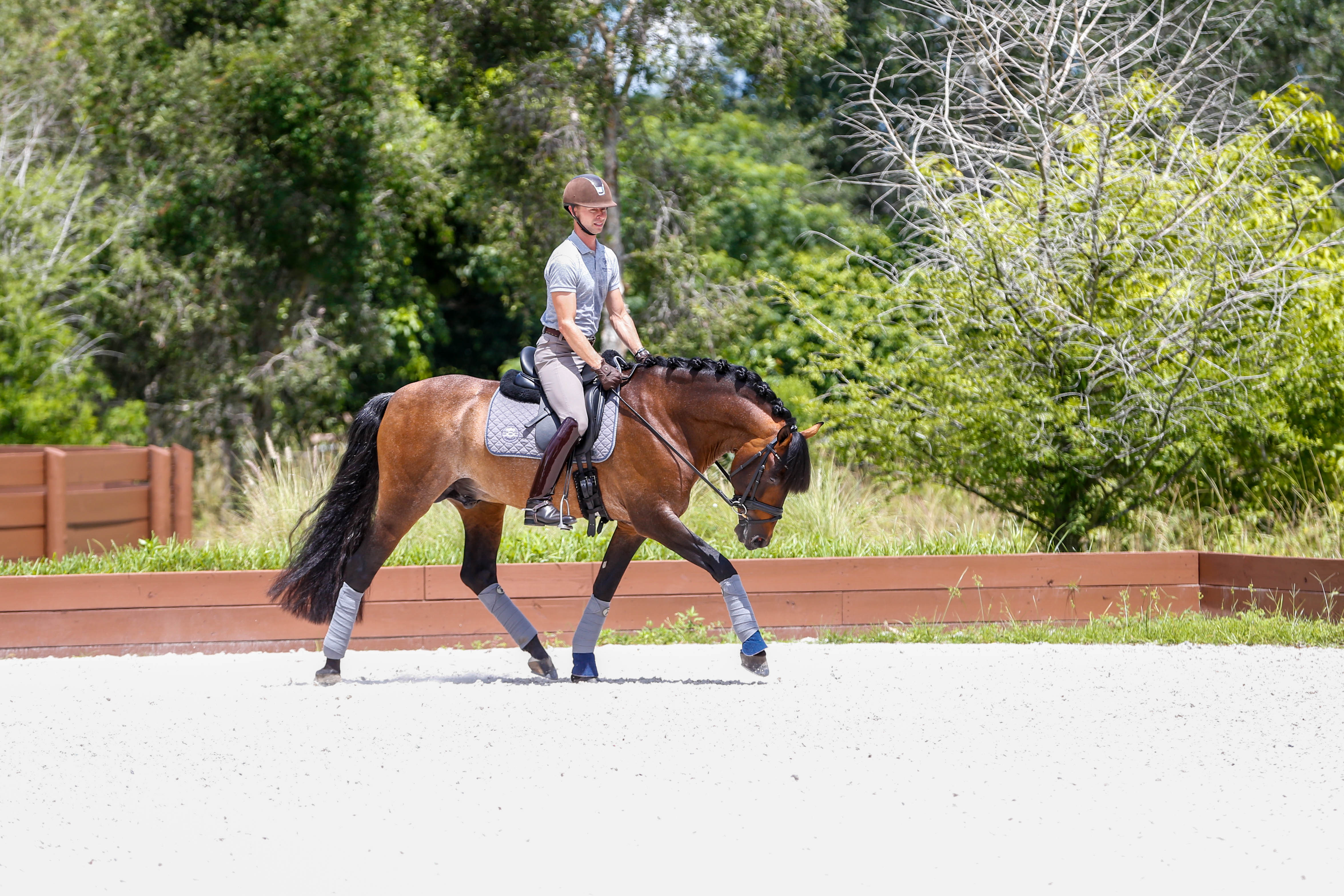
A horse becomes too fatigued if you tax all of the muscles every day, and fatigue brings on injuries. I encourage my horses to stretch by walking them for 20 minutes before I begin the work. Time spent in walk could be in hand, under saddle, on the treadmill or a combination of these, depending on the horse. As you can see in the photo on page 31, I then need to be able to stretch the horse forward and downward in rising trot. My goal is to have my horse reaching for the contact, taking his nose down and out, so that all the vertebrae in his spine open and all of his muscles lengthen. Once I’m able to find a release in both directions with the horse correctly flexed, I work on being able to lengthen and shorten his stride within a long and low frame.
Longeing is a real skill and, unfortunately, I don’t always see it executed in a way that’s constructive for the horse. I want my horses to longe in a speed and posture proportionate to their age and training. I personally like to longe all my horses. My older horses will longe once every two weeks and some of the babies will longe lightly three to four times a week so I can see how they utilize their bodies and to see their symmetry in both directions.
Before longeing, I have them walk for 20 minutes so their tendons and ligaments have a chance to warm up. If my horses longe consistently, I change the direction in which they start each time. I don’t longe for more than 10 minutes in each direction and I prefer not to use a round pen, so I can walk up and down the sides of the arena, utilizing those straight lines. I typically longe horses on Tuesdays, which are the days following their day off, or alternatively on Sundays, which are easy days. I’m usually training Tuesday through Saturday, and specific days can be harder or lighter depending on how the horse is feeling and our competition goals. If the horse has been great the day before, the next day is often lighter. Sundays may also include hacking, work over cavalletti or piaffe work in hand, and when the opportunity presents, I also enjoy riding the horses in the polo fields, where they can build up a bit of speed. This is super for the mindset of the horse.
Here are some exercises to help both riders and horses cross-train and improve performance.
Test Your Flexibility
Gradually bend at your waist and dangle your fingertips toward your toes. Don’t force the stretch, but note areas of tension or asymmetry. Touching your toes for a second won’t increase your flexibility. This pose needs to be maintained for up to a minute and done daily before you will start to see improvement. Document your improvement and take this time into consideration when expecting your horse to develop something new, for example, more bend in travers or even just a more mature frame and self-carriage.
Exercise 1: Rider Leg Swings
Like many riders, my lower back can become sore, and this is usually related to me not being warmed up enough before I start riding. If I skip my warm-up, I can usually feel tightness in my lower back by my second or third ride. This is a problem when I have six or more horses to ride in a day.
Before each ride, I stretch by using two different types of leg swings—a front and side leg swing. Both of these exercises stretch the inner and outer thigh muscles, hip joints, glutes, hamstrings, calves and quadriceps. The wonderful thing about leg swings is that they’re portable—no extra equipment is needed—and they can be performed virtually anywhere—in the stable yard using the fence for extra support or leaning up against the wash stall. I will often wear my riding boots with my spurs because they’re heavier, therefore creating a little more tension. You can perform these stretches by doing the following:
1. Lift one leg by dropping your weight down on the foot of the opposite leg.
2. For the front leg stretch (see photos below), swing your leg forward and then back, keeping your core engaged and shoulders relaxed. For the side stretch (see photos below), swing your leg out to the side and then across the front of your body.
3. Do each stretch for 10 reps on each leg.
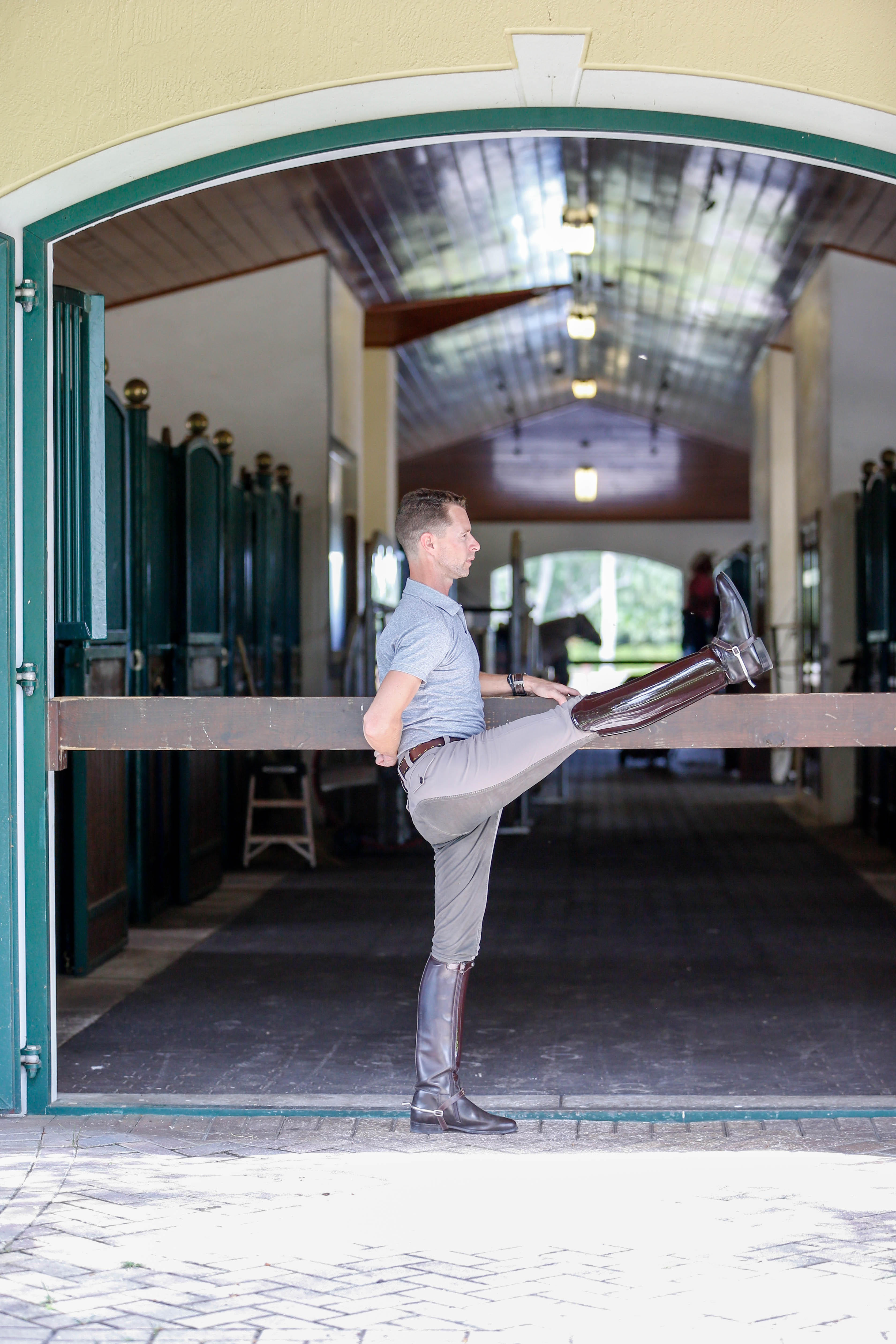
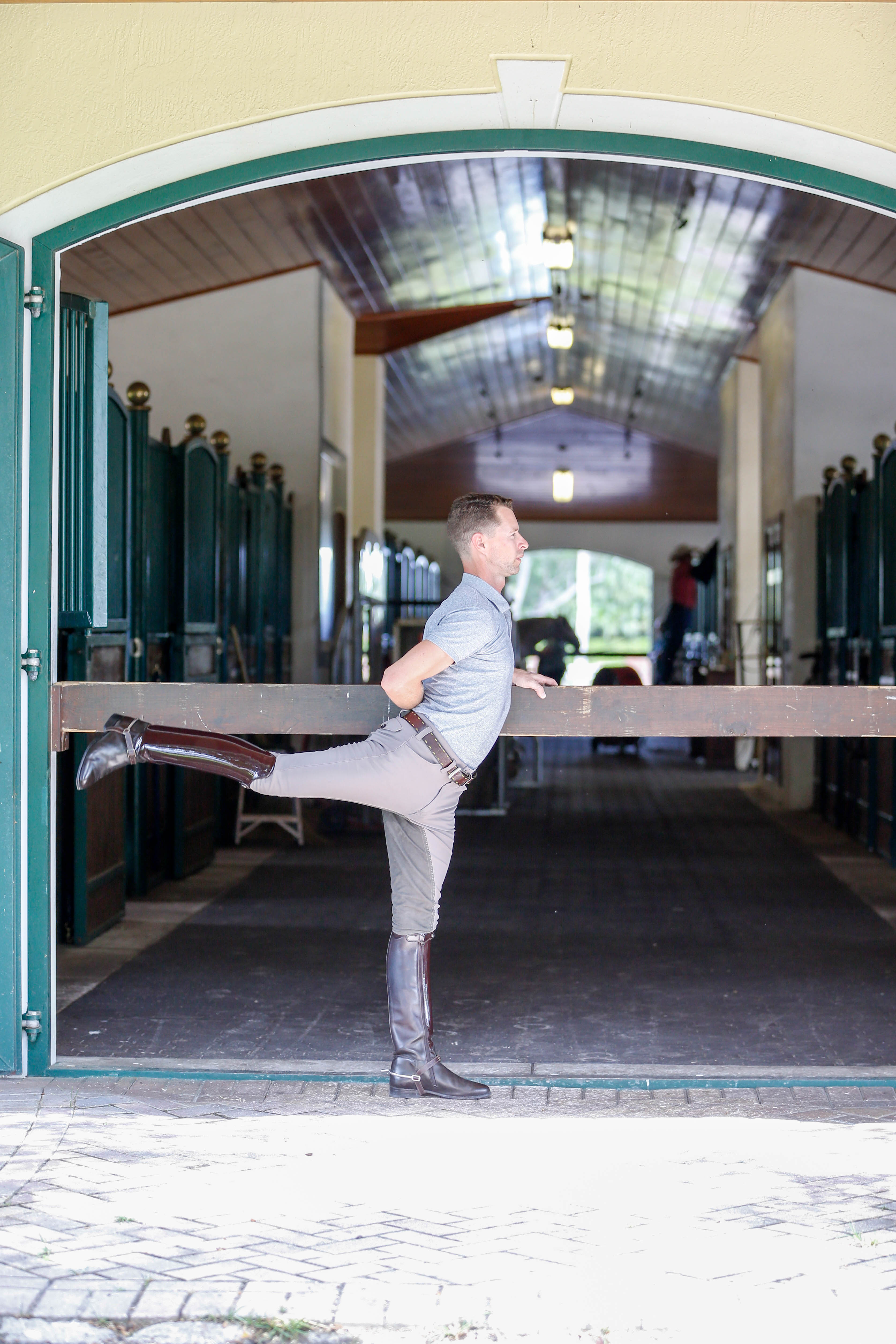
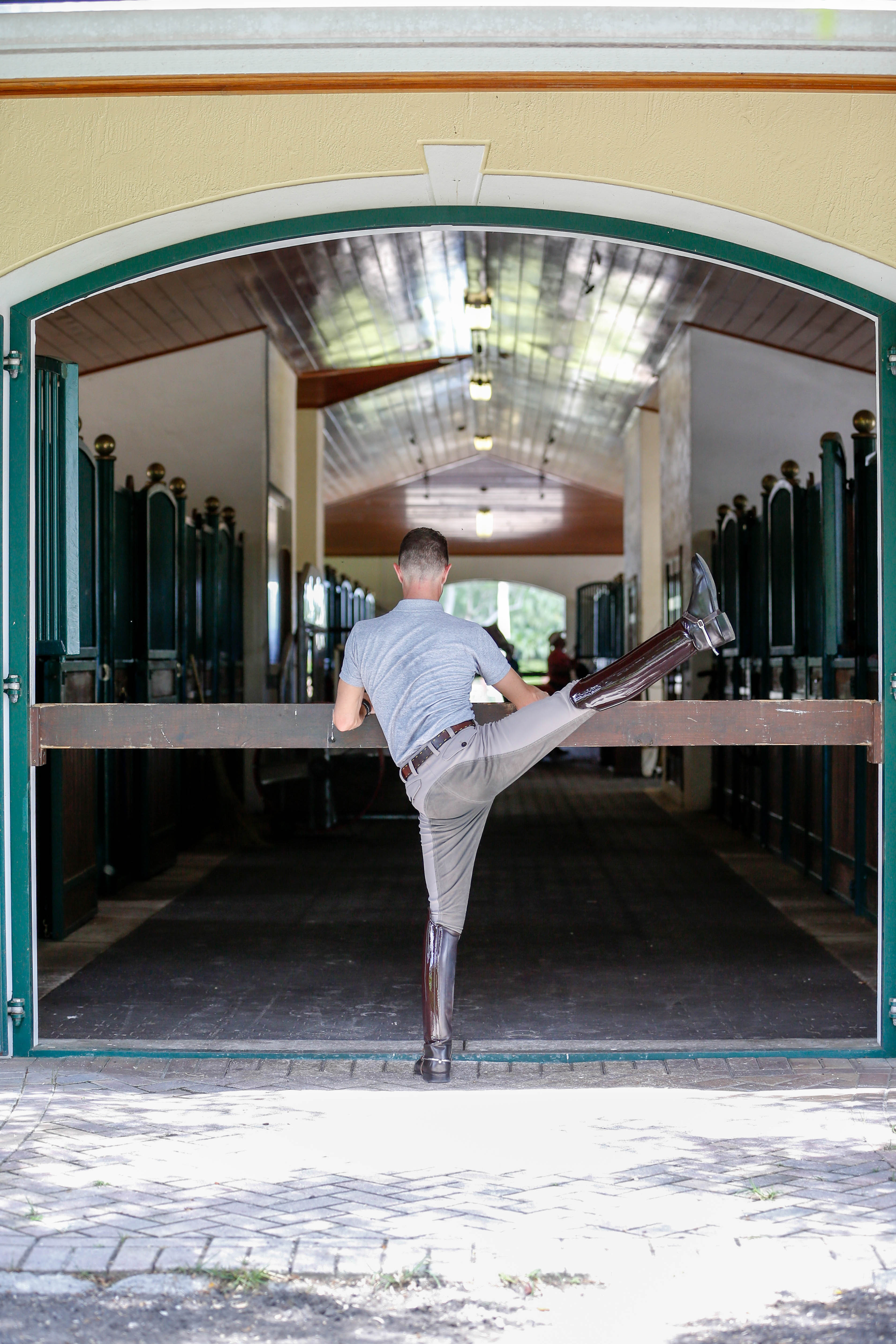
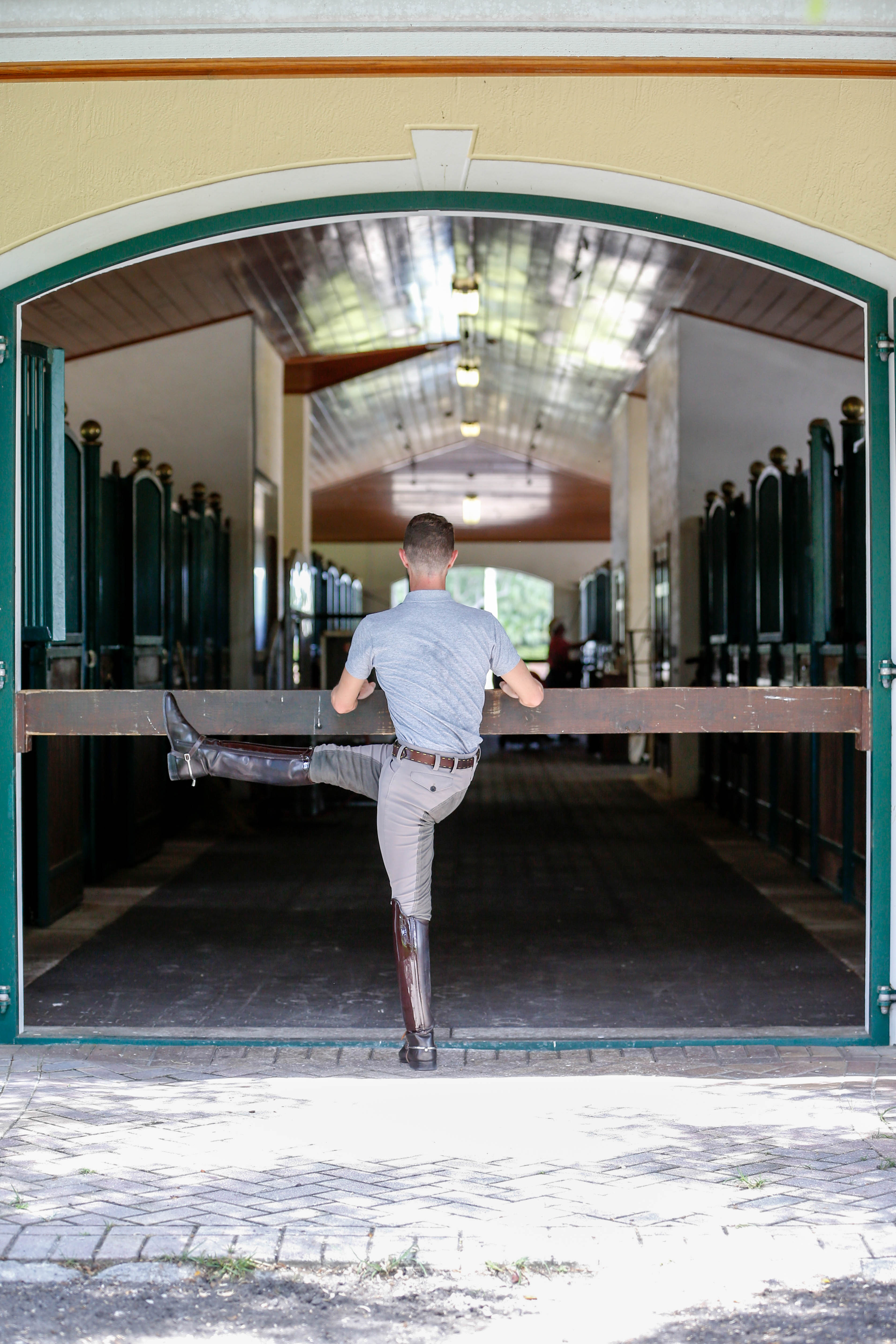
Exercise 2: Test Symmetry
If a rider is feeling more confident tracking right, I have him analyze what qualities he likes about going in that direction. I then ask him to transfer that same feeling tracking left. I want the rider to appreciate the positive aspects from his preferred direction and reinforce those feelings on the more difficult side. Rather than worry about what’s wrong, I want to bring the strong aspects to the difficult direction.
To achieve this, you can ride a simple figure eight. Be mindful of what you feel when you’re tracking toward your more comfortable direction, and when you switch to ride the opposite direction of the figure eight, try to imitate what you felt while tracking in your preferred direction.
To advance this exercise, I’ll ride a counter-bend at the trot or canter position in the difficult direction. This reverse psychology works well for many riders.
Exercise 3: Walking Over Cavalletti
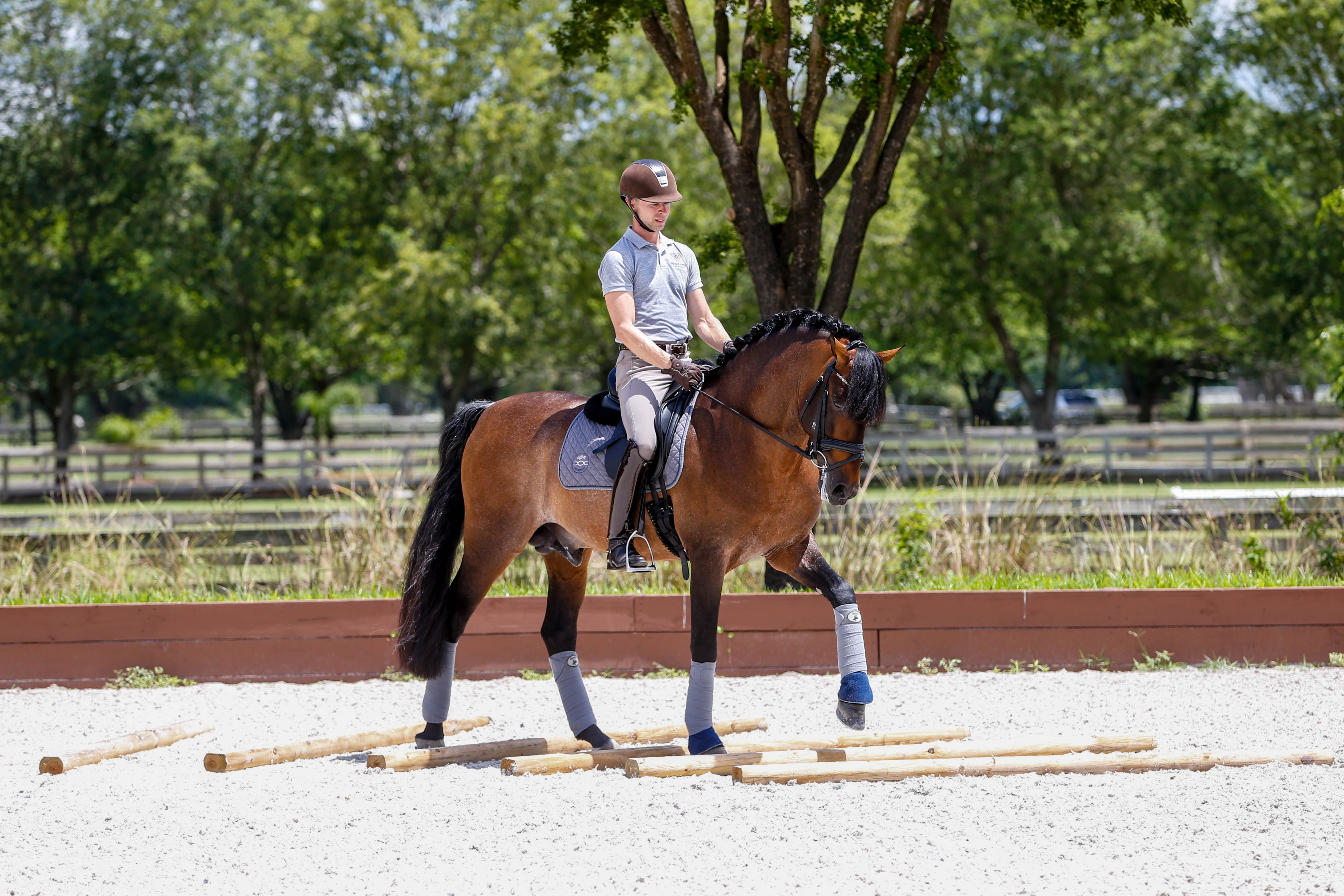
Most riders view cavalletti as elevated trotting poles, which are helpful, but I also use them at canter and as a walking exercise with the poles set about 2 to 2½ feet apart. Walking over cavalletti is a great exercise for hot horses because it encourages the horse to wait or he will step on the poles. Additionally, if the horse rushes, he is disagreeing more with the cavalletti and less with the rider. Cavalletti are also great if you want to work on lengthening the horse’s stride. In this exercise, the horse will either clip the poles with his hooves or he will extend his stride and figure it out.
1. Set up walking poles/cavalletti on a curved/fan line or circle with one end of the cavalletti poles consistently closer together.
2. Ride the horse through the exercise at medium or collected walk, utilizing the narrow end, and ride a lengthened or extended walk toward the wider end of the poles.
3. Try varying the horse’s frame while allowing the exercise to maintain the horse’s length of stride.
I also use the poles to regulate the walk after a downward transition. For example, a horse learning the simple changes may anticipate the upward transition to canter. I simply make a transition from canter to walk on approach to the walk poles and allow the poles to do their job. Correctly placed poles and a strategically timed walk transition will encourage the horse to listen better to my waiting aids and be patient in the transition. The horse is unlikely to anticipate the upward transition while navigating the walk poles.
Managing Expectations
We’ve all had that amazing ride and then when we get on the horse the next day we expect to begin where we left off. Rather than having that expectation, we should pay thought to the development of muscle memory in the horse and rider. Just because you are having trouble with an exercise that you have previously ridden successfully, doesn’t mean that you are not developing. Sometimes failure helps make us stronger. It certainly does when lifting weights. Even though you may have successfully lifted 40 pounds yesterday but can’t repeat as many reps today, providing you feel you honestly worked to your limit, you are still developing those muscles.
The same rings true in dressage. Think about why you may be struggling with the exercise and ask yourself these questions: Are you sitting in a way that allows it to happen? Is the basic element in the exercise under control? If not, step back and work on that element until you own it. This will help develop that muscle memory without exhausting those muscles. I truly understand pushing my body, feeling both the negatives and positives, and how that relates to pushing the horse. This means knowing when to stop for the day and finding a positive note to finish on.
It’s also important to address the management side of horses as top athletes. Our team at Marcus Fyffe Dressage has hands-on involvement with the care of the horses everyday, and we notice any tender areas when the horses are being thoroughly groomed and inspected. We also take full advantage of treatment modalities, such as magnetic blankets, laser, ultrasound, vibrational therapy, massage, osteopathy, acupuncture, ice and poultice. When not resting, our horses are moving. They are turned out and hand-walked in a way that they are using their body correctly and are aware of their handler. We utilize our treadmill as well as vary the footing that we train on—our covered arena footing and outdoor arena footing are slightly different in density. Consistently training on harder footing can take its toll on a horse’s joints while footing that is too soft can stress soft tissue.
When it comes to cross-training horse and rider, there are numerous options available to add variety and reap rewards of improved flexibility, endurance and strength. However, the best fit is always the one that’s enjoyable to the horse and rider and produces an enriching response at the end of the day.
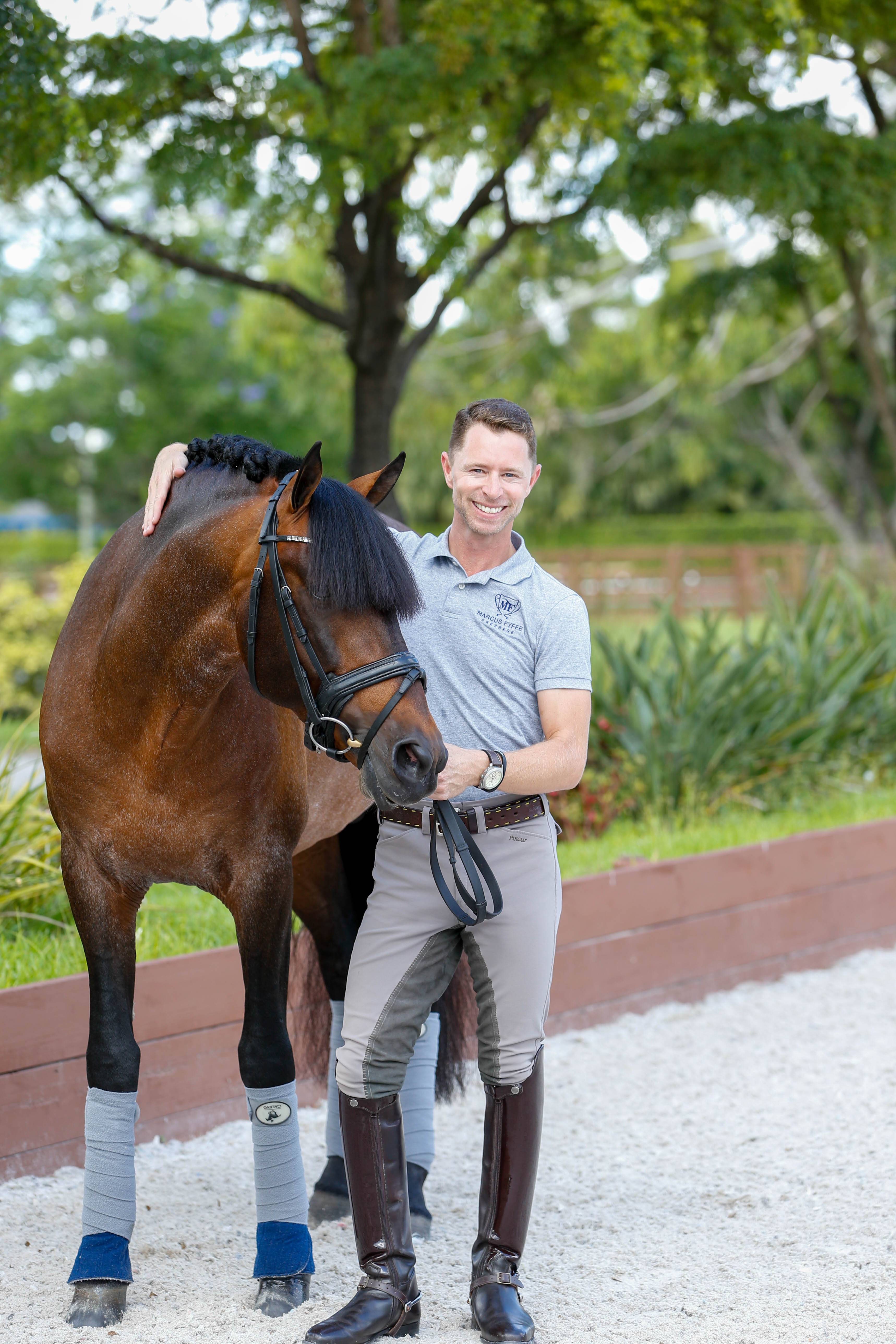
Nicholas Fyffe, an Australian citizen and Grand Prix rider, offers a depth of experience to his clients from starting young horses to training for international competition. Nicholas began his riding career as an international three-day eventer. After choosing to focus solely on dressage, he trained extensively in Germany under top dressage riders, gaining a wealth of information that guides his approach today. Nicholas contributed to the Australian team’s gold medal at the 2007 Tri Nations Cup in Johannesburg, South Africa, and he has ridden on four consecutive Nation’s Cup Teams in Wellington, Florida. He has qualified multiple horses for the World Young Horse Championships and has shown many horses through the levels up to Grand Prix. Among his training success stories is Fiero HGF, the P.R.E. stallion whom he has developed from a 3-year-old to winning the 2016 Adequan/USDF United States P.R.E. Association’s Championship at Grand Prix. Nicholas is currently listed on the Australian National Dressage Future Squad. He and his husband, Canadian Olympian David Marcus, own Marcus Fyffe Dressage, a year-round training operation in Wellington, Florida.








